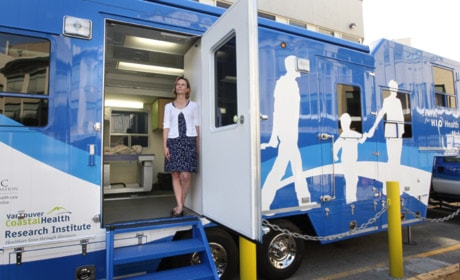VANCOUVER — The adage might well suggest the hip bone is connected to the back bone, but researchers in British Columbia will soon be scouring the province as they try to determine if the health of those bones differs from region to region.
Vancouver’s Centre for Hip Health and Mobility has unveiled a mobile research laboratory, the first of its kind in Canada, that will travel to different B.C. communities to study the bone health of residents.
The goal, says Dr. Heather McKay, is to see why bones remain strong in some communities but deteriorate in others, while also developing solutions to prevent such degeneration.
“In science, most of what we know comes from data that were collected in major centres, where you’ve got high-level technical equipment to do the measurements,” said McKay, the centre’s director.
“So it’s very seldom where you can go into smaller communities and obtain measurements on any population with high-tech equipment. They just don’t exist there.”
Each year, more than 4,000 British Columbia seniors fracture their hip. About 800 of those, or one-fifth, die within 12 months.
Fall-related hip fractures cost the province about $75 million annually in direct hospital expenses.
McKay says studying rural populations might well reveal important data and trends that, up to now, have been overlooked.
“What we do is we measure individuals who live in urban centres and we assume that those outcomes apply to people in rural and outlying areas. We don’t necessarily know that’s true,” she said.
“We are thinking about First Nations communities in the north. We need to look at individuals and cultures and where they live geographically and then customize those interventions to meet their needs.”
Researchers inside the mobile laboratory plan to conduct tests that include bone imaging, physical activity, muscle function, falls risk, and cognitive function in seniors.
The laboratory is equipped with state-of-the-art equipment that uses three-dimensional technology to measure total bone, fat and muscle mass and predicts the future risk of falls with 75 per cent accuracy.
Ida Chong, B.C.’s Minister of Healthy Living and Sport, says the mobile laboratory is an innovative way to meet the current and future needs of the province’s aging population.
“Currently one in seven (British Columbians) are considered seniors, age 65 and older, and by the year 2031, it will be one in foxur,” she said.
“We want to find ways to prevent injuries and have quality of life improve.”
Chong, MLA for the Oak Bay-Gordon Head riding, says the laboratory will provide information on the most effective solutions to prevent, detect and treat problems that affect bones and joints before they cause deterioration and damage.
“If we can prevent one of those 4,000 falls that occur every year, that would be an improvement.”
Donna Templeton has seen first-hand just how much of an improvement working with the hip centre can yield.
Templeton, 70, has fractured her patella, shoulder, wrist and hand in cycling, skiing and tennis accidents. She enrolled in a centre study that measured muscle power and worked out hard twice a week.
“You did see advances in your strength and stamina, and stamina has always been a problem for me,” she said.
“I did feel better after doing that.”
The study also examined bone strength and Templeton says she has no doubt taking a similar show on the road would do a lot of British Columbians some good.
“If they can take it out into the communities, I think it will be wonderful,” she said.
“They’ll love it and it will be a real help. There just aren’t the facilities in many communities to interest and motivate people to get out and exercise.”
Dr. Maureen Ashe, one of the researchers who will be working out of the mobile laboratory, plans to take the facility into the B.C. Interior in October.
“The population that I’m looking at are seniors after hip fractures,” she said, adding she’s interested in possible exercise programs seniors could benefit from during the recovery phase.
“The unique thing about the mobile lab is that it combines both the ability to look at bone health but also falls risk because we know if fractures occur, it’s because of both the propensity to fall but also bone health.”
While some might suggest bone health is a concern primarily for the elderly, Templeton would like to see a greater focus on young people.
“Doctors should start focusing on younger patients to get their bone densities done early and then they’ve got a baseline,” she said.
“When you’re young, you just think ’I’m healthy.’ I think paying closer attention to the preventative aspects would be beneficial.”
